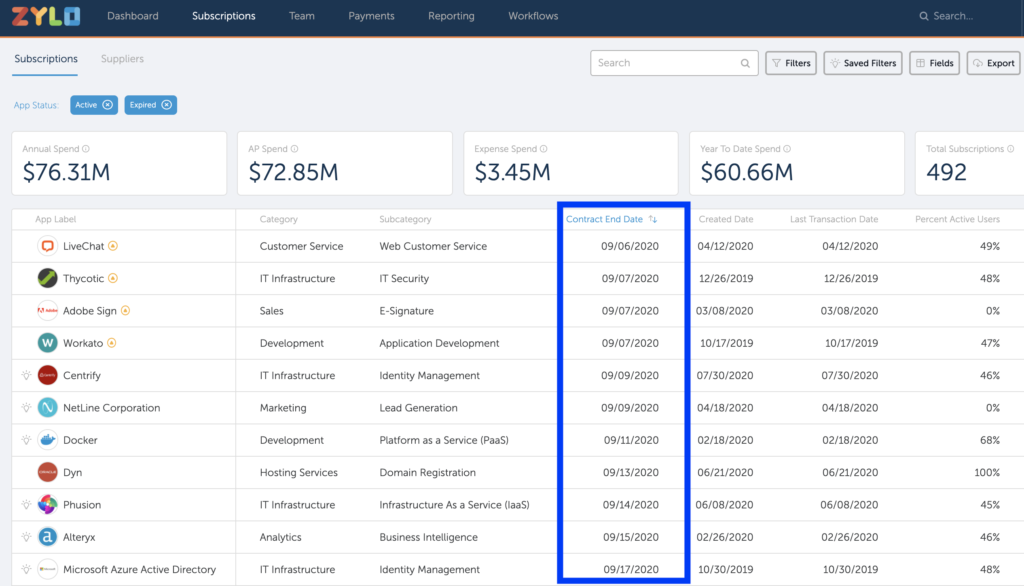
FinOps Software Explained: Benefits, Tools & Key Features
Table of Contents ToggleWhat FinOps Means in the Modern Cloud EnvironmentWhy...
Back
Back
Search for Keywords...
Blog

Table of Contents
Automatic subscription renewals offer the convenience of continued service and data for your organization’s SaaS applications. But, on the other hand, there’s a significant “oops” factor: Details of notification periods and renewal dates frequently get misplaced or forgotten, leading to unwanted renewals and unnecessary costs.
A study of Zylo’s database of more than $30 billion in SaaS spend shows that a large organization will undergo one SaaS application renewal every business day on average.
But, without a practical SaaS management framework or system of record that addresses SaaS renewals, many businesses are exposed to increased costs. And if an application exists as shadow IT, it may expose the company to increased risks.
The most crucial element in an automatic renewal strategy is information. There is no “standard” notification period, so it’s essential to find this specific information when possible. While notification periods of 30, 60, and 90 days are most common, some applications have notification periods as short as one day or as many as 365 days or more.
To find the notification period and renewal date, locate the original SaaS agreement, contract, or original purchase receipt. Remember that these dates may refresh or update if and when notable account changes occur, such as upgrading to new products or features.
Use this information to build an application renewal calendar that charts the dates that significant applications or subscriptions will renew. The calendar can also record other important SaaS contract details such as features, pricing, and assigned users to build a system of record for all SaaS applications.

Locating and storing contract renewal dates in a system of record (such as Zylo’s SaaS management platform) makes managing SaaS application renewals more effective and proactive.
With one SaaS renewal occurring every business day, it can be challenging to determine which applications to address first with a more proactive renewal strategy.
After deploying effective SaaS management practices in hundreds of large organizations, Zylo SaaS consultants recommend prioritizing the applications with the closest renewal dates or notification periods, or by applications with the highest amount of investment so that automatic renewals to catch you off guard.
“Should this application be renewed?” is one of the first questions to drive a proactive renewal strategy. Frequently, the answer is not immediately apparent. One of the most effective ways to reach a renewal decision more quickly is to evaluate the application’s user activity.
With the right data, determining the basic utilization of a SaaS application is relatively straightforward. A good baseline is looking at login activity within the last 30, 60, and 90 days.
About 38% of all SaaS licenses go unused in a typical 30-day period, according to Zylo benchmarking data.
If users haven’t logged in during the previous 30 days or more, consider eliminating their license or deploying these underused assets to other users.
Analyzing feature provisioning and utilization offers a deeper level of analysis that can reveal key data for renewal decisions. As an example, video conferencing application Zoom offers Basic or Pro licenses. The Pro license provides users the upgraded ability to host meetings lasting 40 minutes or more. If your utilization analysis found a notable number of Pro users who didn’t regularly use this premium feature, the users could be downgraded to Basic licenses at renewal, and the business could save on license costs.

By analyzing feature utilization within applications, such as meeting minutes used in Zoom, renewal and rightsizing decisions can be made based on data.
IT no longer solely owns software purchasing or direct management of applications. Business units, teams, and individual employees now hold the majority of SaaS spending and control more applications than ever before.

This trend is a direct outcome of increasingly specialized software verticals, end-user specific marketing and product growth, and low cost and technology requirements.
Unfortunately, another outcome of distributing SaaS applications’ management across the organization is that renewal information can become obscured, leading to unplanned or unknown renewals.
IT, procurement, or software asset management teams can re-assert control over renewals by centralizing information about every application and its renewal data in a system of record, then collaborating with departments and employees about upcoming renewals.
Creating a software review process is another proactive approach to tackling the challenges of automatic subscription renewals. Prohibiting or limiting teams and employees’ ability to purchase SaaS without an approval process helps organizations maintain control over renewals. When the only software entering an organization is approved software, it’s much easier to document and store important data such as the renewal date – and subsequently build a calendar with all renewal dates.
An ideal software review process involves multiple stakeholders throughout the organization, including (if applicable) representatives from teams such as IT, software asset management, procurement, finance, and legal. Each representative should vet the proposed software against their team’s respective desired business outcomes.
One review board member should also be responsible for maintaining a system of record for approved incoming SaaS subscriptions. Collecting these details at the beginning of the application’s lifecycle within the organization is far easier than tracking down the application’s information after the fact.
Re-asserting control over automatic SaaS subscription renewals requires good documentation, ongoing monitoring of the tech environment, and proactive planning. For many organizations, a SaaS management platform that offers discovery capabilities and a record system for renewal dates and other application details is an essential tool.
If your organization experiences the surprise associated with an unplanned automatic SaaS renewal, consider the steps above to beat back unwanted costs and the downsides of being locked into additional contract terms. We also created a handy checklist to help ensure you don’t miss a beat. Download it for free here. And, get additional insights at our SaaS Renewal Management Resource Center.

Table of Contents ToggleWhat FinOps Means in the Modern Cloud EnvironmentWhy...

Table of Contents Toggle1. Collect and Store Renewal Details2. Prioritize Upcoming...

Table of Contents Toggle1. Collect and Store Renewal Details2. Prioritize Upcoming...

Table of Contents ToggleKey Themes That Shaped SaaS Management in 20251....
| Cookie | Duration | Description |
|---|---|---|
| cookielawinfo-checkbox-analytics | 11 months | This cookie is set by GDPR Cookie Consent plugin. The cookie is used to store the user consent for the cookies in the category "Analytics". |
| cookielawinfo-checkbox-functional | 11 months | The cookie is set by GDPR cookie consent to record the user consent for the cookies in the category "Functional". |
| cookielawinfo-checkbox-necessary | 11 months | This cookie is set by GDPR Cookie Consent plugin. The cookies is used to store the user consent for the cookies in the category "Necessary". |
| cookielawinfo-checkbox-others | 11 months | This cookie is set by GDPR Cookie Consent plugin. The cookie is used to store the user consent for the cookies in the category "Other. |
| cookielawinfo-checkbox-performance | 11 months | This cookie is set by GDPR Cookie Consent plugin. The cookie is used to store the user consent for the cookies in the category "Performance". |
| viewed_cookie_policy | 11 months | The cookie is set by the GDPR Cookie Consent plugin and is used to store whether or not user has consented to the use of cookies. It does not store any personal data. |
